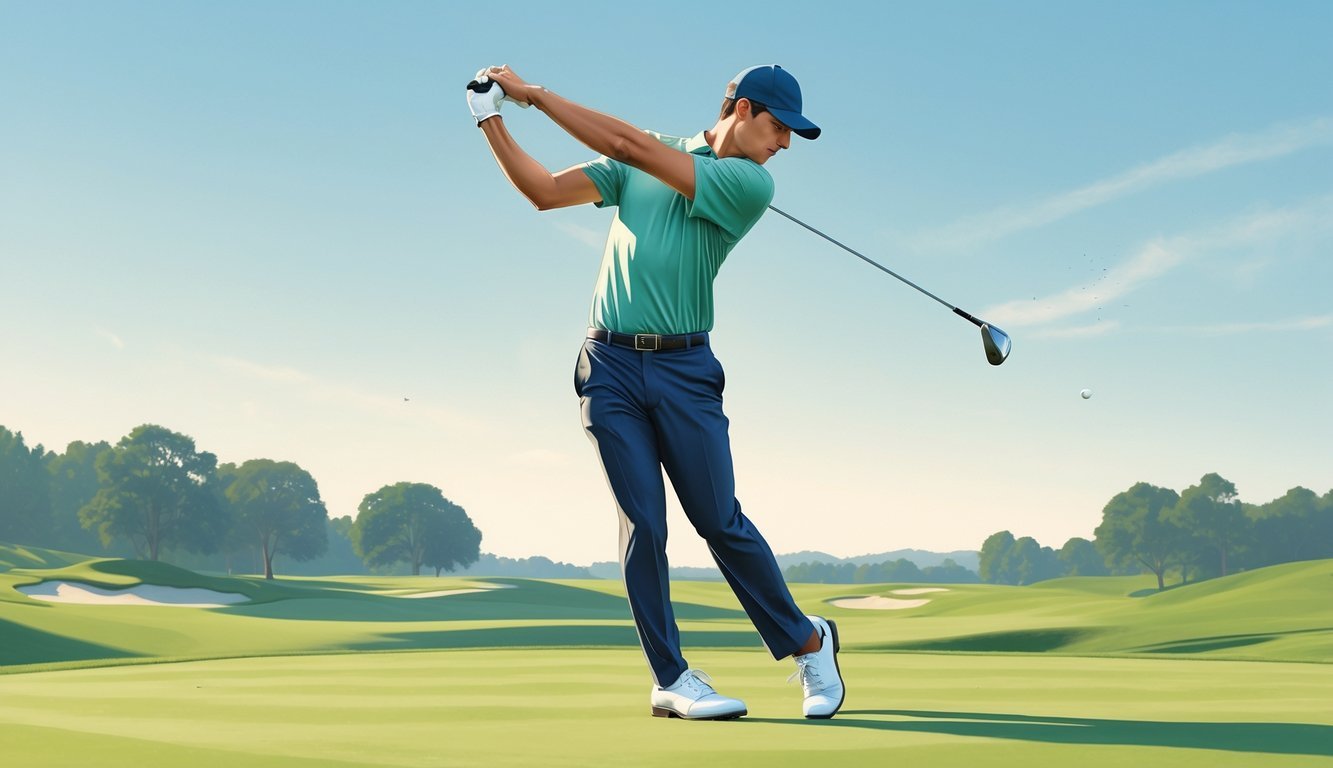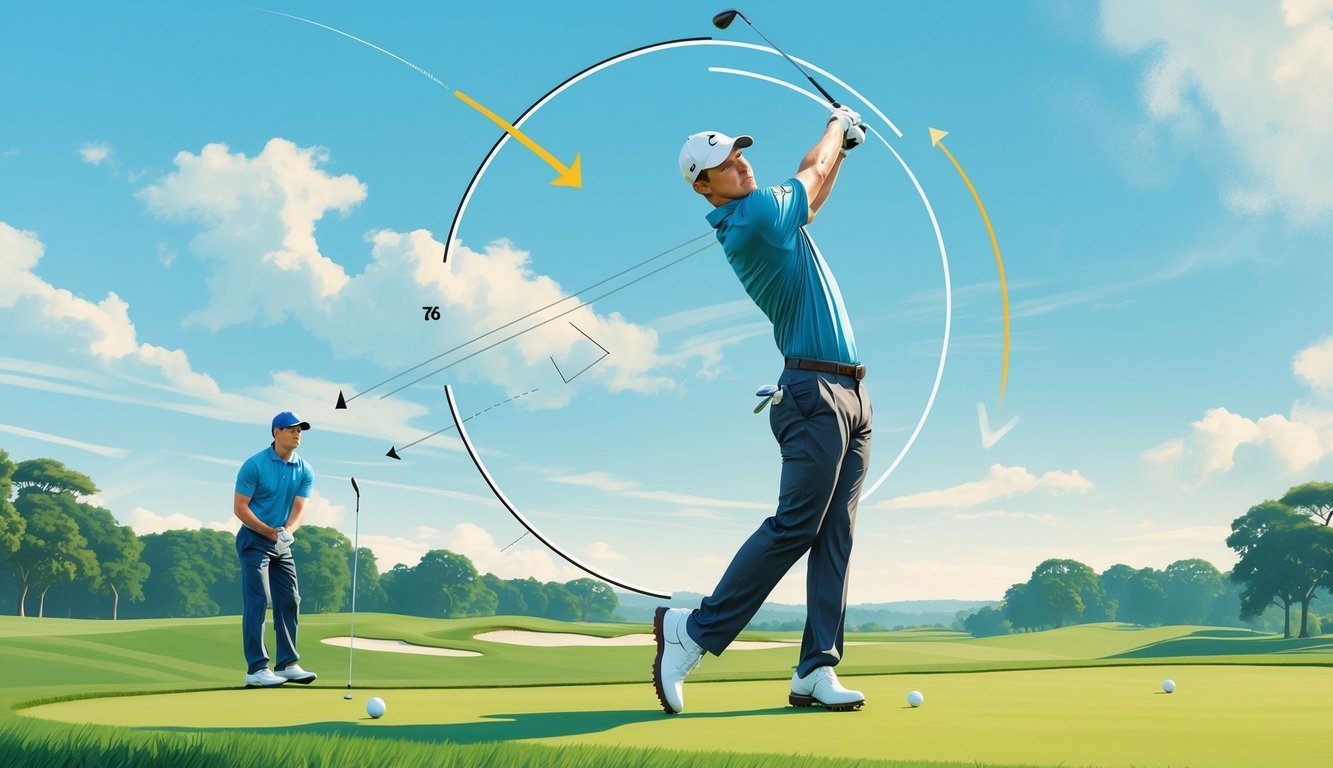Physical Address
304 North Cardinal St.
Dorchester Center, MA 02124
Physical Address
304 North Cardinal St.
Dorchester Center, MA 02124
A straight left arm during a golf swing enhances power, control, and consistency, enabling a wider swing arc and improving shot accuracy and timing.

If you want to make solid contact and drive the ball farther, focus on keeping your left arm straight during your golf swing. A straight left arm gives you a wider swing arc, which means more power and better consistency in your shots.
You’ll also find it much easier to control the club and time your swing when your left arm stays extended.
Don’t force your arm to lock out.
Just keep it relaxed but extended.
Let your right arm help push the swing, so your left arm holds its position without getting tense.
It’s a small change, but honestly, it can really transform your game.
Practice this move regularly, and you’ll start to see your swing path improve.
You might even notice fewer mistakes, like bending your lead arm too early.
Stick with it, and your shots should get more accurate and predictable.

Keep your left arm straight in the golf swing, and you’ll get a wide arc, more power, and better control.
This position supports your swing’s timing and accuracy.
Let’s break down how this works for your backswing, consistency, and the crucial moments of downswing and impact.
Your left arm leads the swing, and when it stays straight, it widens the arc.
That extra width means your clubhead travels farther, so you generate more speed and power on contact.
If you keep your left arm firm but not stiff, you store up energy for the downswing.
That momentum is what sends the ball flying.
A straight lead arm also helps you turn your shoulders fully during the backswing.
Full turns mean more power potential.
If your left arm bends too early, you lose width and your power drops.
A straight left arm helps you keep your swing plane steady, which really improves clubface control.
When your arm stays extended, the clubface lines up to your target more often, so your shots are more likely to go where you want.
You’ll also notice better timing between your arms and your body.
If your left arm collapses, your timing can go off and you might start hitting slices or hooks.
That left arm also sets your wrist and hand position for impact.
When it’s stable, you get cleaner contact and more reliable distances.
During the downswing, your straight left arm guides the club on the right path.
You keep the width you built up in the backswing, so you don’t lose power at impact.
Your left arm also helps control the clubface angle, keeping it square or slightly open depending on what you’re aiming for.
At impact, a stable left arm keeps the clubhead moving along the right line.
You’ll see more consistent results and probably feel a lot more confident over the ball.

If you want width and consistency in your swing, work on keeping your left arm straight.
Here’s how your setup, grip, and some drills can help.
Start with a solid base.
Stand with your feet shoulder-width apart and keep your balance.
Line up your body square to the target.
Bend forward slightly from your hips to set an athletic posture.
This lets your shoulders turn freely, which supports an extended left arm during the backswing.
Let your left arm hang naturally from your shoulder.
Don’t force it straight—just keep it ready to extend.
Avoid tension here; a tight left arm can lead to that “chicken wing” move or an early elbow bend.
Grip the club firmly but not too tight.
That keeps your wrists flexible.
Hinge your wrists early in the swing so your arms stay connected and your left arm stays straight.
As you start your backswing, try pushing away a little with your right arm.
This helps extend your left arm.
Your trailing arm (left arm for right-handed players) should stay on plane, roughly parallel to the ground during the backswing.
Let your left elbow lead the motion, but don’t let it bend too soon.
The right wrist hinge and arm extension together build the width and power you need.
Use simple tools like alignment sticks or try a split grip drill to build muscle memory.
For instance, you can put an alignment stick along your lead arm to feel the straight line as you swing.
Try the split grip drill: hold the club with your hands separated.
This helps you set your wrists right and extend your left arm.
Another good drill is to grab your right wrist with your left hand and make slow practice swings.
You’ll feel your left arm straighten naturally during the backswing.
Get some video feedback or work with a coach to check your arm position and swing plane.
It really helps to see yourself on camera.
Watch out for bending your left elbow too soon, gripping the club too tightly, or letting your arm “chicken wing” near the top of your swing.
These habits shorten your swing width and weaken your shots.
Don’t cast the club by releasing your wrist hinge early.
Stay connected between your arms and your body as you rotate.
If your arms or shoulders get tense, your swing can get jerky.
Relax your grip and focus on a smooth, fluid motion.
If you’re slicing or pulling, check your alignment and make sure your left arm and club stay on plane during the backswing.
Sometimes just a small tweak in your posture or wrist set can fix it.

Getting your left arm in the right spot can really shape your swing and boost your control.
You’ll also discover how to build power and why your grip matters.
Focus on a smooth shoulder rotation as you swing.
Don’t force your left arm to lock up—just let it extend naturally as your body turns.
Try slow swings to get a feel for the right arm position.
A straight left arm gives you a wider arc, which usually means more clubhead speed.
It also helps you keep the club on the right path and makes it easier to hit the ball cleanly.
Try swinging with a towel tucked under your left arm to keep it close to your body.
Make half swings while focusing on arm extension before you add speed.
Using a mirror is helpful for checking your form.
Hold the club firmly but not tightly with your left hand.
Let your left palm face slightly inward, and keep your grip pressure light enough that your arm can extend without straining or bending.
A longer, straighter left arm gives you more leverage to build clubhead speed.
When you combine that leverage with your body’s rotation, you transfer more energy into the ball and get more power.
Not really.
Plenty of players let their left arm bend a bit at the top of the backswing.
The key thing is to keep your left arm extended enough to get the right swing width.
That helps you stay in control as you move through the swing.